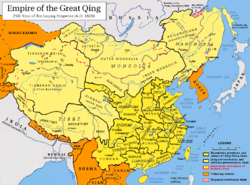Governance over the Provinces
Unlike the Ming provincial administration which consisted of three governors the Qing provinces were governed by a single Governor or "Xunfu (巡抚)" who held substantial power. Although all provincial agencies communicated with the central government through him, he himself was subordinate to a Governors-general "Zongdu (总督)". While nominally superior to a Governor, usually the Governors-general cooperated closely with the Governor and acted jointly in reporting to the central government. [2]
Under the authority of the Governors were two types of agencies: the Provincial Administration Commissions and the Provincial Surveillance Commissions. The Provincial Administration Commissioner, acting as a lieutenant-general, handled financial duties. The Provincial Surveillance Commissioner managed judicial and oversight functions. Additionally, each province had an unofficial Provincial Education Commissioner who oversaw educational institutions and certified candidates for the civil service exams. Circuit Intendants, known as "Daotai (道臺)" operated within the provincial administration as liaisons between the prefectures and the provincial authorities. [3]
This page is based on this
Wikipedia article Text is available under the
CC BY-SA 4.0 license; additional terms may apply.
Images, videos and audio are available under their respective licenses.


